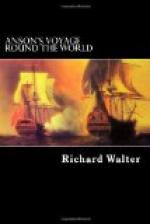At last, in 1713, by the Treaty of Utrecht, that closed the famous War of the Spanish Succession, in which Marlborough gained his wonderful victories, Spain consented to resign her claim to a monopoly of trade with her colonies so far as to permit one English ship a year to visit the American coasts. But the concession was unavailing. It granted too little to satisfy the traders. The one ship was sent, but as soon as her cargo had been cleared she was reloaded from others which lay in the offing, and the Spanish colonists, only too glad to enrich themselves, actively connived at the irregularity. The Spanish cruisers endeavoured to enforce respect for the treaty. They claimed, not without justice, to search English vessels seen in American waters and to confiscate forbidden cargoes. English pride rebelled, and English sailors resisted. Violent affrays took place. The story of Jenkins’ ear kindled a wild, unreasoning blaze of popular resentment, and by 1739 the two countries were on the verge of war. In the temper of the English people Walpole dared not admit the Spanish right of search, and he was compelled by popular feeling to begin a war for which he was not prepared, in a cause in which he did not believe.
It was at this point that Anson’s expedition was fitted out.
George Anson was born in 1697. He came of a lawyer stock in Staffordshire. In 1712 he entered the navy as a volunteer on board the Ruby. His promotion was rapid, owing partly to his own merit, partly to the influence of his relations. By 1724 he was captain of the Scarborough frigate, and was sent out to South Carolina to protect the coast and the trading ships against pirates, and also against the Spanish cruisers, which were already exercising that right of searching English vessels that finally provoked the war of 1739. There he remained till 1730. He was again on the same station from 1732 to 1735. In 1737 he was appointed to the Centurion, a small ship of the line carrying sixty guns, and was sent first to the West Coast of Africa and then to the West Indies. In 1739 he was recalled to conduct the expedition which has made his name so famous.




